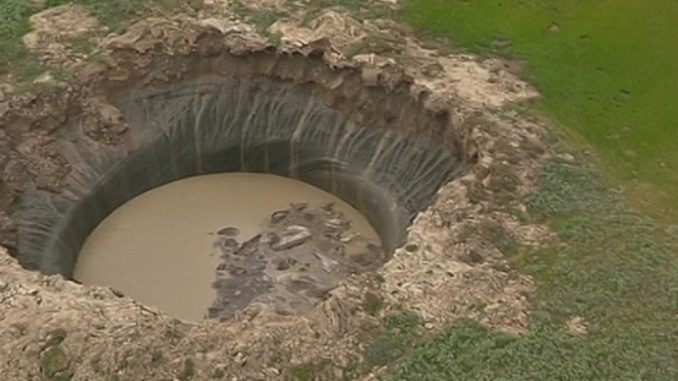
A mysterious sinkhole discovered last year in Siberia’s Yamal peninsula, has expanded to 50 meters in depth and is gradually filling with water, say Russian scientists.
Researchers who are puzzled by its origins say it was likely caused by gas explosions.

BYPASS THE CENSORS
Sign up to get unfiltered news delivered straight to your inbox.
You can unsubscribe any time. By subscribing you agree to our Terms of Use
Latest Video
The giant hole located not far from Gazprom’s Bovanenkovo gas field in Russia’s northern Yamal Peninsula has been expanding and additional smaller craters have been appearing around it.
RT reports: The whole area is within Russia’s key strategic oil and gas region – the Yamalo-Nenets Autonomous Okrug.
The crater, discovered last year, has been gradually filling up with water and turning into a lake. Over the past winter and spring the water level in the crater has risen by 10 meters and it will continue to rise, scientists said, according to the government website of the Yamal-Nenetsky region.
“I am very surprised by the size, it’s very big!” Japanese reporter for Asahi Shimbun Terukhiko Nouse, who accompanied the science expedition, told local TV. “And the sound of the glacier melting…this sound amazes me.”
By July, two-thirds of the crater had filled with thawed snow and rain water. Scientists have taken tests from the bottom of the crater by lowering special sensors. The results show that the object is unpredictable raising fears of a descent into the crater.
“Generally speaking, [the descent] will be very extreme,” Vladimir Pushkaryov, the head of the Russian Center of Arctic Exploration, told local TV. “First of all there is still [soil] caving-in, as well as thawed clay is still sagging.”
Earlier this year, scientists said that 20 mini-craters recently appeared around the hole-turned-lake in Yamal. Other crater discoveries have been made by locals.
Many theories have been put forward to explain the origin of the eerie holes – from the wild UFO-related ones to speculation about them being caused by global warming.
The giant sinkhole’s emergence is likely linked to thermal gas emissions, like most of the round-shaped tundra lakes located on the peninsula, said the head of a group researching the region’s craters and deputy director of the Moscow-based Oil and Gas Research Institute, Vasily Bogoyavlensky.
The process of the craters’ formation is caused by the melting of permafrost due to global warming, he said. As the result underground gas emissions occur causing the soil to rise and forming hill-like objects, he explained adding that some of them can blow up.
“These hills, reaching a diameter of up to two kilometers and a height of dozens of meters, look quite exotic in the tundra plains. Gradually these objects disintegrate at high temperatures and form craters. However, a year ago, based on the formation of the Yamal crater, we’ve learned that they can even explode,” he said.
The Russian scientist has previously warned that rising temperatures will trigger the melting of permafrost and the ejection of large underground deposits of gas hydrates, which have negative effect on climate.




